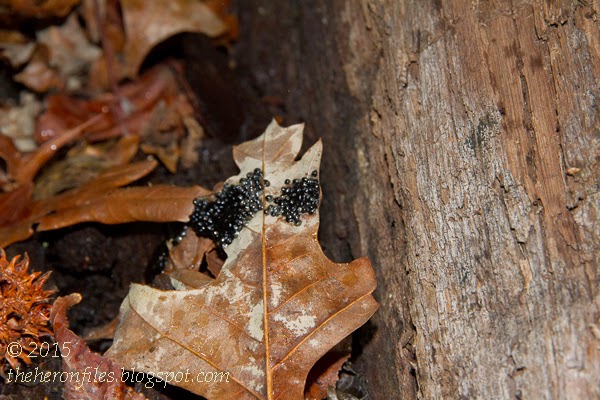 |
| Our group. Photo by S. Burton |
 | ||
| First Southern Leopard Frog of the Night |
None of us were sure what they were. Most salamanders and frogs would lay their eggs in the near-by pool so they would stay moist. So who would leave them out on a rotting log? Later we discovered the likely source of these eggs. They would be frogs eggs that never made it to the water. (possibly disturbing image next, you are warned)
This frog had succumbed to a predator and showed the same type of eggs as we had seen earlier. A bit of a gruesome find but also fascinating to see the eggs still with the frog. The carcass was drying out so it had been there for a while. We aren't sure what the predator was or why it would leave such a meal behind. Surely the eggs must be a good source of fat and protein. And all of that meat. That will remain a mystery.
Now back to the less gruesome. The lead group had found a small cove [do vernal pools have coves?] that had several dozen calling southern leopard frogs and masses of frogs eggs.With all of the human commotion the frogs had moved away from the edge out of camera range. But as Sharon scanned the water's surface out to 30-50 ft, the surface was dotted with tens of pairs of eyes. And those were only the ones looking in our general direction. It was fascinating to see the eye-shine from the frogs on the dark water.
 |
| Southern Leopard From Egg Mass |
 |
| Same Type of Eggs but Under Different Lighting |
 |
| Mabee's Salamander |
By the time we reached the far side of the pool we were once again separated into two group. Here's the other half on the other side of a finger of the pool. I think that must be Fred with his double-barreled light source at the far right side. He is the only one you could pick out by his headlamp.
 Along the way I found this cool-looking feather floating in the water and a wonderfully posed frog. The frog showed much more green and distinctive markings than any of the previous ones. It was just sitting on the side of a fallen tree. You can see the rounded, irregular spots on the back, the strong lines along the sides, and a hump in the middle of the back. I'm not sure what that hump is; perhaps it is where the leg muscles attach?
Along the way I found this cool-looking feather floating in the water and a wonderfully posed frog. The frog showed much more green and distinctive markings than any of the previous ones. It was just sitting on the side of a fallen tree. You can see the rounded, irregular spots on the back, the strong lines along the sides, and a hump in the middle of the back. I'm not sure what that hump is; perhaps it is where the leg muscles attach?In this wonderful night, we had a great climatic find. A group of calling frogs even larger than the first (or at least what I saw of that group). And eggs everywhere. Play the movie to hear the frogs calling. It was too dark to see anything except the flash from someone's camera.
There were several pairs caught in amplexus. The male will grab onto the female's back and stick with her. This helps stimulate her to release her eggs which he then fertilizes. The southern leopard frog leaves a gelatinous egg mass that is in the shape of a rough ball. We touched a few, gently, and they are firmer than they look.
On our way out we again heard the calling spring peepers. They had been joined by upland chorus frogs. Both frogs are much smaller than the southern leopard frog and tend to call from vegetation making them much harder to find. But Kory did find this pair in a small ditch along-side the road. A great find that was a perfect way to finish off the night.
Thanks to Elisabeth, for organizing, and everyone else for making a great adventure. Hopefully in a few weeks we will be out again and find new salamanders and frogs.



















